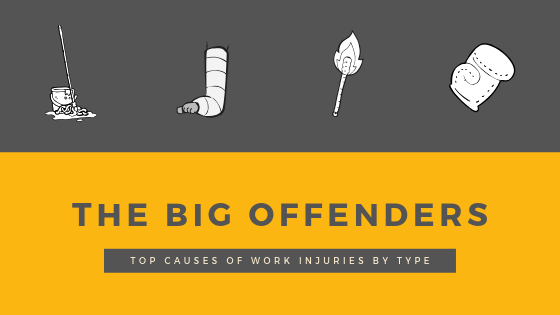
The National Safety Council reports that there are 4.5 M workplace injuries recorded each year. This means a worker is injured – either permanently or temporarily – and his life endangered every 7 seconds. The most common injury causes are coming into contact with equipment and different objects, overexertion, sprains and strains, as well as trips, slips, and falls.
Of all the causes of work injuries, trips, slips, and falls, and strains combined for the biggest lost-time claims, based on statistics. Struck by incidents accounted for the next biggest total.
Following are the leading causes of work injuries according to accident type:
- Slips, Trips, and Falls – In terms of severity and frequency, this accident category is tops. Although injuries sustained on same level (not at height) were number 1 in terms of frequency, falls from an elevated area contribute to more severe injuries. Most incidences of slips, trips, and falls resulted in injuries to the ankle, knee, or back. Hospitals, restaurants, non-profits, transportation, roofing, and carpentry were included in the industries that were most affected.
You can prevent injuries from this type of accidents by requiring your workers to wear the right footwear, and walking carefully. Running through work environments is never a good idea. Ensure that the floor surfaces are clear and dry. Don’t allow items like cords or rugs to just lie around the area. Secure them.
Encourage workers to focus on the walking path. Tell them to refrain from carrying things that may block their view. Getting rid of possible walkway hazards can help avoid injuries that these obstructions may cause.
- Sprains and Strains – This accident type caused a significant number of injuries that led to lost-time claims. While this type of work accident may not be as severe as other accident categories, it is the most common. A majority of these injuries were sustained from pushing, pulling, and lifting. Over 50% of the injuries happened on the knees, back, and shoulders. These were most frequent in the restaurant industry, as well as the firefighting, residential construction, and healthcare (including home health and hospitals) industries.
To help keep employees away from injuries in the workplace, integrating safe lifting practices and procedures in the workplace is important.
Improper lifting and overexertion can inflict damage to discs, tendons, spines, and cartilage. Make sure that your employees get training on the proper way of lifting loads. Provide them with gloves and other necessary support equipment to help them move loads. Train your workers to cooperate with one another to complete bigger and heavier jobs.
- Burns or Scalds – While injuries caused by burns or scalds were not as common as the previous types of accident, this category resulted to more severe injuries. Most affected body parts were the hands and lower arms. Burns or scalds were most common in auto shops and restaurants. This is due to the fact the workers were more exposed to fire and other hot objects or substances compared to other industries.
When working with grease and other hot liquids, your workers should wear protective gear like gloves and aprons. In food service work environments, handles for hot pans and pots should be turned inwards to keep them from getting knocked over. Potholders must be available for lifting them.
- Struck By – The most common incidences of this type of injury are often the result of being struck by flying or falling objects or being struck by a colleague or any other person. The severest injuries of this kind happened when people were hit by motor vehicles. Often, the driver didn’t notice them or the vehicle’s brake or other safety mechanisms did not engage properly.
Train your workers on the proper use of the machinery. This will help lower the incidence of struck by accidents. Do not allow workers to use the machines improperly, a common example of which is standing on an elevated loading bucket. Workers must be discouraged from standing directly behind or in front of machines while in operation.
Injuries in the workplace can have a significant effect on both your business and workers. The good news is, a lot of common workplace injuries can be prevented by putting safety measures in place, as well as by teaching your employees the best practices in the industry.

